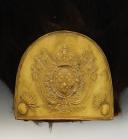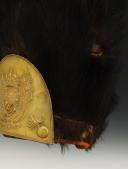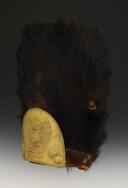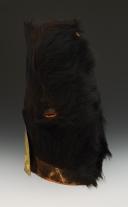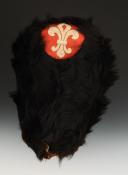
INFANTRY FUSILIER GUARD ROYAL BEARSKIN HAT, 1816 model, Restoration era. 27645
Sold out
FUR-LINED INFANTRY FUSILIER BONNET OF THE ROYAL GUARD, model 1816, Restoration. 27645
Natural leather frame, made up of elements sewn together edge to edge with white linen thread. At the level of the cap, the frame is cut on the bias, causing the back part to drop by about 30 mm.
The back of the frame is split into a triangle shape; on each edge, a strap is intended for adjusting the cap.
At the front, the bonnet measures 420 mm in height, front to the top of the crown 370 mm, back to the base of the crown 330 mm, width at the top approximately 290 mm.
Bearskin made up of pieces sewn together, it is threaded onto the frame and sewn at the bottom with the edge of the cap. At the location of the tightening buckle, the skin is cut to allow for cap adjustment.
Plume holder sewn on the left side. A small opening is made 170 mm from the lower edge, intended to receive the base of the plume. Inside the skin, a leather gusset is sewn.
A double black lace is sewn at the top of the bonnet and intended to attach the front tassel.
Interior cap in black waxed sheepskin (H 120 mm) cut into seven wolf teeth points. The tips of the wolf teeth points are folded over themselves to allow the lace for adjusting the cap to pass through. The lower edge of the cap is folded outward from the frame, over the bearskin, to a height of 10 mm and sewn.
Round scarlet cloth crown Ø 135 mm. In the center, a white fleur-de-lis embroidered in cotton thread, H 130 mm, width 95 mm. The edges of the cloth are folded over and roughly sewn.
Brass plate, H 155 mm x 205 mm, stamped with the central coat of arms of France and a grenade in each lower corner. Plate bordered by a framing molding composed of a double raised fillet. Edges folded over themselves. On the back of the plate, a tubular tab fits into the leather where a slot is made for this purpose.
France.
Restoration.
Good condition, the laces for attaching the cord are missing, lower edge of the interior cap worn, steel clip that secures the plate inside the bonnet missing.
Natural leather frame, made up of elements sewn together edge to edge with white linen thread. At the level of the cap, the frame is cut on the bias, causing the back part to drop by about 30 mm.
The back of the frame is split into a triangle shape; on each edge, a strap is intended for adjusting the cap.
At the front, the bonnet measures 420 mm in height, front to the top of the crown 370 mm, back to the base of the crown 330 mm, width at the top approximately 290 mm.
Bearskin made up of pieces sewn together, it is threaded onto the frame and sewn at the bottom with the edge of the cap. At the location of the tightening buckle, the skin is cut to allow for cap adjustment.
Plume holder sewn on the left side. A small opening is made 170 mm from the lower edge, intended to receive the base of the plume. Inside the skin, a leather gusset is sewn.
A double black lace is sewn at the top of the bonnet and intended to attach the front tassel.
Interior cap in black waxed sheepskin (H 120 mm) cut into seven wolf teeth points. The tips of the wolf teeth points are folded over themselves to allow the lace for adjusting the cap to pass through. The lower edge of the cap is folded outward from the frame, over the bearskin, to a height of 10 mm and sewn.
Round scarlet cloth crown Ø 135 mm. In the center, a white fleur-de-lis embroidered in cotton thread, H 130 mm, width 95 mm. The edges of the cloth are folded over and roughly sewn.
Brass plate, H 155 mm x 205 mm, stamped with the central coat of arms of France and a grenade in each lower corner. Plate bordered by a framing molding composed of a double raised fillet. Edges folded over themselves. On the back of the plate, a tubular tab fits into the leather where a slot is made for this purpose.
France.
Restoration.
Good condition, the laces for attaching the cord are missing, lower edge of the interior cap worn, steel clip that secures the plate inside the bonnet missing.
Reference :
27645
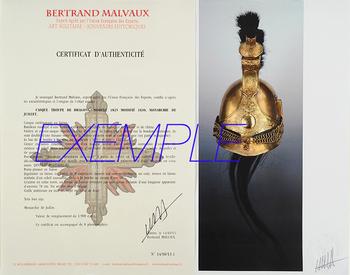
Next update Friday, december 26 at 13:30 PM
FOR ALL PURCHASES, PAYMENT IN MULTIPLE CHECKS POSSIBLE
bertrand.malvaux@wanadoo.fr 06 07 75 74 63
SHIPPING COSTS
Shipping costs are calculated only once per order for one or more items, all shipments are sent via registered mail, as this is the only way to have proof of dispatch and receipt.
For parcels whose value cannot be insured by the Post, shipments are entrusted to DHL or Fedex with real value insured, the service is of high quality but the cost is higher.
RETURN POLICY
Items can be returned within 8 days of receipt. They must be returned by registered mail at the sender's expense, in their original packaging, and in their original condition.
AUTHENTICITY
The selection of items offered on this site allows me to guarantee the authenticity of each piece described here, all items offered are guaranteed to be period and authentic, unless otherwise noted or restricted in the description.
An authenticity certificate of the item including the description published on the site, the period, the sale price, accompanied by one or more color photographs is automatically provided for any item priced over 130 euros. Below this price, each certificate is charged 5 euros.
Only items sold by me are subject to an authenticity certificate, I do not provide any expert reports for items sold by third parties (colleagues or collectors).
FOR ALL PURCHASES, PAYMENT IN MULTIPLE CHECKS POSSIBLE
bertrand.malvaux@wanadoo.fr 06 07 75 74 63
An authenticity certificate of the item including the description published on the site, the period, the sale price, accompanied by one or more color photographs is automatically provided for any item priced over 130 euros. Below this price, each certificate is charged 5 euros.
Only items sold by me are subject to an authenticity certificate, I do not provide any expert reports for items sold by third parties (colleagues or collectors).

